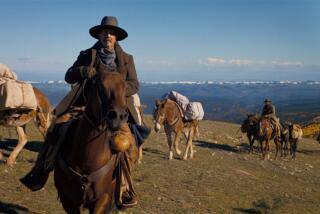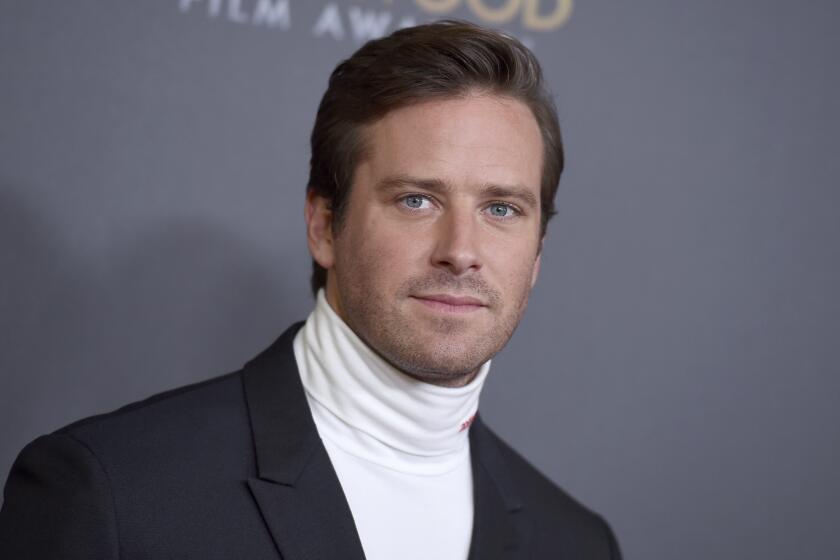At Its Best, ‘Spirit’ Takes Flight
“Spirit: Stallion of the Cimarron” is a film that manages to soar, but only when its horses do. Under ordinary circumstances, of course, horses are not known to fly, and they don’t really here. But when this new animated feature from DreamWorks is at its best, they definitely seem to.
The story of a feisty mustang of the Old West who absolutely, positively will not be broken, “Spirit” is being touted for the way it combines traditional two-dimensional and computer-generated three-dimensional animation and for being the anti-Mr. Ed. This is a horse that won’t talk, so don’t ask him, thank you very much.
Of course, Hollywood being Hollywood, “Spirit” hedges its bets by giving the animal voice-over narration (read by Matt Damon) that sounds like this is one horse who found time to take creative writing courses. Also filling in the gaps are a musical’s worth of songs by Bryan Adams, who collaborates with composer Hans Zimmer to attach a lyric to almost every mood change Spirit faces, from his birth (“Here I am, this is me”) to later homesickness and separation (“Wherever I wander, here I will always return”). That’s more communicating than some people do.
Speaking or silent, horses apparently have a reputation for being difficult to animate, and co-directors Kelly Asbury and Lorna Cook have taken pains to be as authentic as possible. Impressive horse consultants were hired, and what’s described as “a wide variety of neighs, whinnies and other horse sounds” were carefully recorded.
That determination to be true to what horses went through way out West makes parts of the production problematic for the youngest viewers. However authentic, it’s unpleasant to see Spirit starved and subjected to sadistic riding crops and spurs. Although the horse gives as good as he gets when he’s captured by the U.S. Cavalry, he’s trussed up in so many constraining ropes and harnesses that you feel like you’re watching “Stallions in Bondage” instead of a friendly animated cartoon.
“Spirit” was likely conceived by writer John Fusco in part as a love note to the West before we covered it with parking lots, snowmobiles and SUVs, an attempt to produce a history of the region written not “from the saddle of a horse” but “from the heart of one.” It’s at its best during its purely visual moments, like the three-minute opening sequence, which is so complex that it was nine months in the design stage alone.
Following an eagle in swooping flight, the camera, in what looks like one long, continuous shot but isn’t, moves all in a rush through the canyons of our collective imagination, thrusting us into a constantly changing landscape that includes the Grand Canyon and other frontier landmarks. It unfolds in such a breathless rush that you can feel how exciting it must have been to animate.
Inevitably, the story parts of “Spirit” are more ordinary and predictable. We see the horse being born and watch him “grow from colt to stallion, racing with the eagle, soaring with the wind.” Then, with a face that makes him resemble an equine John Travolta, he becomes leader of the Cimarron herd and learns that “with that honor comes responsibility.”
What also comes with maturity are encounters with unpleasant white men, intent on subjugating the West in general and Spirit in particular. They’re epitomized by the Colonel (James Cromwell), who serves as bondage master during Spirit’s brief stay with the cavalry. If the white people cause every bit of the trouble in this film, the Native Americans, living as it happens in perfect harmony with the natural world, are just as schematically presented as uniformly virtuous. This is especially true of the young Lakota brave Little Creek (Daniel Studi), who hooks up with Spirit and happens to possess a fetching paint mare named Rain that catches Spirit’s eye.
Despite its good intentions, “Spirit” is more self-conscious and uninspiring from a dramatic point of view than one might have wished. Still, whenever it threatens to get bogged down in earnest dramaturgy, a stirring visual sequence like a surge through swirling rapids or a leap from pinnacle to pinnacle rouses us. If horses could fly, this is surely what they’d look like.
MPAA rating: G. Times guidelines: Some mildly disturbing scenes of cruelty to animals.
‘Spirit: Stallion of the Cimarron’
Matt Damon...Spirit
James Cromwell...The Colonel
Daniel Studi...Little Creek
Chopper Bernet...Sgt. Adams
Presented and released by DreamWorks Pictures. Directors Kelly Asbury, Lorna Cook. Producers Mireille Soria, Jeffrey Katzenberg. Screenplay John Fusco. Supervising editor Nick Fletcher. Music Hans Zimmer. Songs Bryan Adams. Production designer Kathy Altieri. Art directors Luc Desmarchelier, Ronald W. Lukas. Animation supervisor Kristof Serrand. Running time: 1 hour, 22 minutes.
In general release.
More to Read
Only good movies
Get the Indie Focus newsletter, Mark Olsen's weekly guide to the world of cinema.
You may occasionally receive promotional content from the Los Angeles Times.











